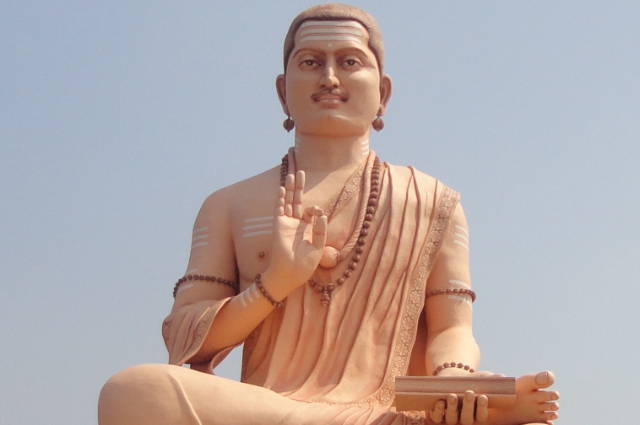The Bhakti movement was revolutionary in the medieval era and transformed the social fabric of the society.
At its core, this powerful movement emphasised personal devotion and love for the divine, which challenged the rigidities and norms of the Vedic society.
While the Vedic religion focused on rituals and intermediation of priests, the Bhakti movement talked about making a direct emotional connection with the deity. The Bhakti movement also rejected the authority and supremacy of Brahmins and promoted an egalitarian approach to religion. The movement was inclusive and embraced people from all backgrounds and castes, opening the gates of spiritual knowledge and enlightenment for all the people instead of a few people from the “upper classes.”
The Bhakti movement also allowed practices from other religions, which promoted a syncretic tradition. Music, dance, and poetry were key feature of the movement, allowing a vibrant and joyful culture. This movement gave rise to some prominent women spiritual leaders too like Mirabai, Akka Mahadevi, and Lalleshwari. Apart from these incredible women, many others participated in the movements, challenged patriarchal norms, and asserted their autonomy in spiritual pursuits.
There were many important social reformers and spiritual leaders which became very popular during the Bhakti movement and one of them was Basavanna.
Basavanna was a 12th-century social reformer, poet, and spiritual leader who played a key role in the Bhakti movement. Basavanna was born in Karnataka in 1134 CE. According to historical records, Basavanna’s rejection of caste and hierarchy began at a young age. As a kid, he would ask questions about the inherent inequalities of the society. Basavanna found it difficult to understand the idea that some people were considered “untouchable” by birth. Belonging to a Shaivite family, he would witness various rituals and ceremonies in his house, but he would try to understand and question them rather than blindly accept them. Despite the societal norms, Basavanna would engage with kids from the so-called “ lower caste” families, which was seen as an unconventional or even as a rebellious act by his community.
As he grew older, his questioning of traditions and challenging of authority only grew. This refusal to adhere to the norms created some tensions with him and his family, but despite this he continued to walk on the path of justice and reform.
A pivotal moment in his journey was his encounter with his guru. Ishanya Guru, a spiritual leader, recognised the potential of Basavanna and took him under his mentorship.It was during this time that he delved into the complexities of Shaivism and explored the world of spirituality. He spent several years here, the teachings here, laid the foundation for the further movements.
Basavanna later worked as minister under Bijalla II from the Kalachuri dynasty. As a minister, he implemented policies that emphasised justice, equality and promoted good governance. He worked on reducing corruption and on ensuring fair treatment for all, despite their background. His economic reforms were meant to support artisans, farmers, and laborers, ensuring fair wages for all. Apart from this, he institutionalised wealth redistribution through state-supported guilds. Basavanna established a community kitchen where people from all sorts of backgrounds could eat together. The appointment of officers under his tenure was based on merit and not caste, which was a challenge for feudal hierarchies. Also, laws were passed to punish those who discriminated against the “lower caste”.
These radical reforms introduced by Basavanna as a minister angered the orthodox groups, and this created pressure on the king. His reforms on widow remarriage, rejection of Vedic rituals and promoting inter caste marriage were liked by some and hated by many others particularly the privileged and orthodox sections of the society who saw his policies as a threat to their social and economic dominance.
Initially, the king supported Basavanna due to his administrative brilliance but later as his influence grew and also due to pressure from conservatives. Some sources suggest that Bijalla II removed Basavanna from his court, while others suggest he had resigned himself from the court. Either way, his exit wasn’t a retirement; rather, it was the start of something huge.
After this, Basavanna continued to spread his ideas about social justice and devotion and focused completely on building the Lingayat movement. The Lingayat believed in Shiva as their supreme deity and wore an Ishtalinga, or a small emblem, showcasing their love and direct connection with their deity. The movement emphasized on rejection of caste norms and equality of all. Women also a part in this movement who took part as poets, philosophers, and even decision makers.
The Lingayat movement denounced meaningless rituals and idol worship, focussing on one’s actions and behaviour towards others above obsessing over elaborate rituals. Lingayats practiced Dasoha or community kitchen, where people from all castes and backgrounds ate together.
The Anubhava Mantapa was also organised by Basavanna which was the first democratic discussion centre in India which was open to people from all backgrounds and a place for intellectual discussion and debate and not just a centre for learning based on religious scriptures like the ones prevalent at that time. Topics of discussion included caste, equality, justice, spirituality and dignity of labour.
Basavanna, his reforms and his movements were clearly way ahead of his time. He challenged Brahmanical superiority in a time where rigid norms were followed, he empowered women to join his movement and take key roles in a time where women had no rights, he promoted dignity of labour before modern equality movements and encouraged a platform for intellectual discussion and debates which was open to all.
The Lingayat movement, founded by Basavanna, is a significant community today in Karnataka. This movement ended up inspiring various social reformers like Kabir, Guru Nanak, and Ambedkar social movements. The idea of justice, equality, and building a true connection with god without the need of intermediaries continues to inspire modern movements.

